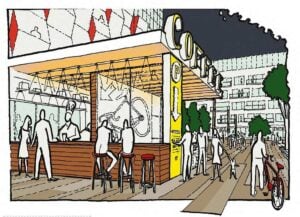
Is there anybody in town who likes the Bergamot Transit Village (BTV)?
Maybe a few folks and they work for Houston, Texas-based mega-developer Hines who has big — very big — plans for redeveloping an industrial property on Olympic Boulevard between 26th and Stewart streets.
Hines purchased the 7.16-acre Paper Mate manufacturing site in 2007 for a reported $75 million. A few years later, the developer announced plans for a 969,000-square-foot complex of offices, creative studio space, apartments and retail stores.
In March of 2011, Hines presented their proposed project to City Council. The development by Gensler architects was universally panned and ridiculed. Hines was told to reduce the project's size and go back to the drawing board if they expected to receive a coveted development agreement.
Five months later, Hines returned to council with a revised plan that was 20 percent smaller. It was still too big, too much of a traffic generator and out of scale with the adjacent low-rise neighborhood. Buildings were still over 80 feet high.
Fast forward. A more residential-friendly Bergamot Transit Village is before City Council Tuesday night.
It's obvious the Hines team has been ignoring residents and City Hall staff because the BTV is still a five-building, 765,095-square-foot development, but now with 473 apartments (93 affordable/workforce units) and 25 artist live/work spaces in three buildings.
The 374,434 square feet of office space in two new buildings and 29,451 square feet of retail/restaurant space is still there. Subterranean parking capacity totals 1,927 vehicle spaces with facilities for 1,284 bicycles. At 85.6 feet, the tallest buildings will be higher than the adjacent Water Garden office complex.
Green spaces and open plazas are scattered throughout the development which will be built in phases and likely sold off as portions are completed.
Architecturally, the Hines development is a disaster. Each building tries to outdo its neighbor for clumsiness, unattractiveness and sheer banality. Between the BTV's 1970s Orange County Business Park layout and faux European-industrial facades, the project is an embarrassment for all involved.
Traffic-wise, the nightmare continues, unabated. As noted in my Dec. 2, 2013, My Write ("Bergamot Transit Village development is a monstrosity," Pg. 4), Hines still underestimates the parking needs.
Architect Ron Goldman has crunched the numbers and tells me that 2,363 parking spaces are needed for office employees alone. Add 747 spaces earmarked for residential parking plus another 100 spaces for restaurant/retail use and even with shared parking, the BTV garage should contain 3,400 spaces instead of 1,927 to prevent the possibility of overflow into nearby residential neighborhoods.
Similar underestimates apply to traffic the BTV will generate. Hines maintains its development will only produce 6,900 additional daily car trips because of car pooling, a tough transportation demand management program, Expo rail and bicycle-friendly initiatives. Even with these mitigations, the real projected trip count is probably closer to 15,000.
Using the lower trip figures Hines supplies, the development will generate major congestion at 34 intersections and on numerous streets throughout Santa Monica and West Los Angeles. In addition, the new roads within the development and two new traffic lights on Olympic will pile on even more problems. Just think of the mess a small brush fire on PCH created two weeks ago times 250 working days a year.
Hines takes credit for approximately two acres of ground space occupied by new streets and sidewalks in its Floor Area Ratio (FAR) calculations. Including streets and sidewalks in FARs? This allows Hines to deceptively present their project as less dense than it really is.
This development is universally despised. Neighborhood groups, activists and everyday citizens are united in opposition to this project. Even the Santa Monicans for Renters' Rights (SMRR) Steering Committee voted to oppose the project — a highly unusual move for the politically powerful organization.
It's interesting to note that one of SMRR's key leaders, Judy Abdo, didn't vote on the motion which is why co-chair Patricia Hoffman noted in her letter to the media last week that the vote was unanimous "among those present and voting."
Abdo and Councilman Terry O'Day co-chaired Save Our City — the developer-supported group that opposed 2008's failed ballot measure "T" (RIFT) that would have temporarily capped commercial developments like the BTV in Santa Monica.
While six out of seven council members were endorsed by SMRR, there's still a chance that enough of them will vote to move this development forward and commit political suicide by doing so.
Council must shoot this down, pronto. They should tell Hines that building height can't exceed 45 feet which is the current code. Insistence on the lower maximum height alone would mean a project half the size of the development that's now proposed. And, one that may be more palatable to residents.
City Council should also instruct Hines to consider adaptive re-use of the old Paper Mate manufacturing plant. Preservation and renovation of just part of the plant along with a couple new residential structures would make for a much more exciting and imaginative development.
Like similar adaptive reuse-driven developments around the world, with the right use mix, the BTV could become a living community center that would also be a home for arts, unique shopping opportunities, entertainment and dining — with less traffic impacts.
We're all watching to see which City Council members will vote for us or for more density, traffic and campaign contributions. The latter choice is guaranteed to torpedo re-election bids in 2014 and 2016.
Bill can be reached at mr.bilbau@gmail.com.








